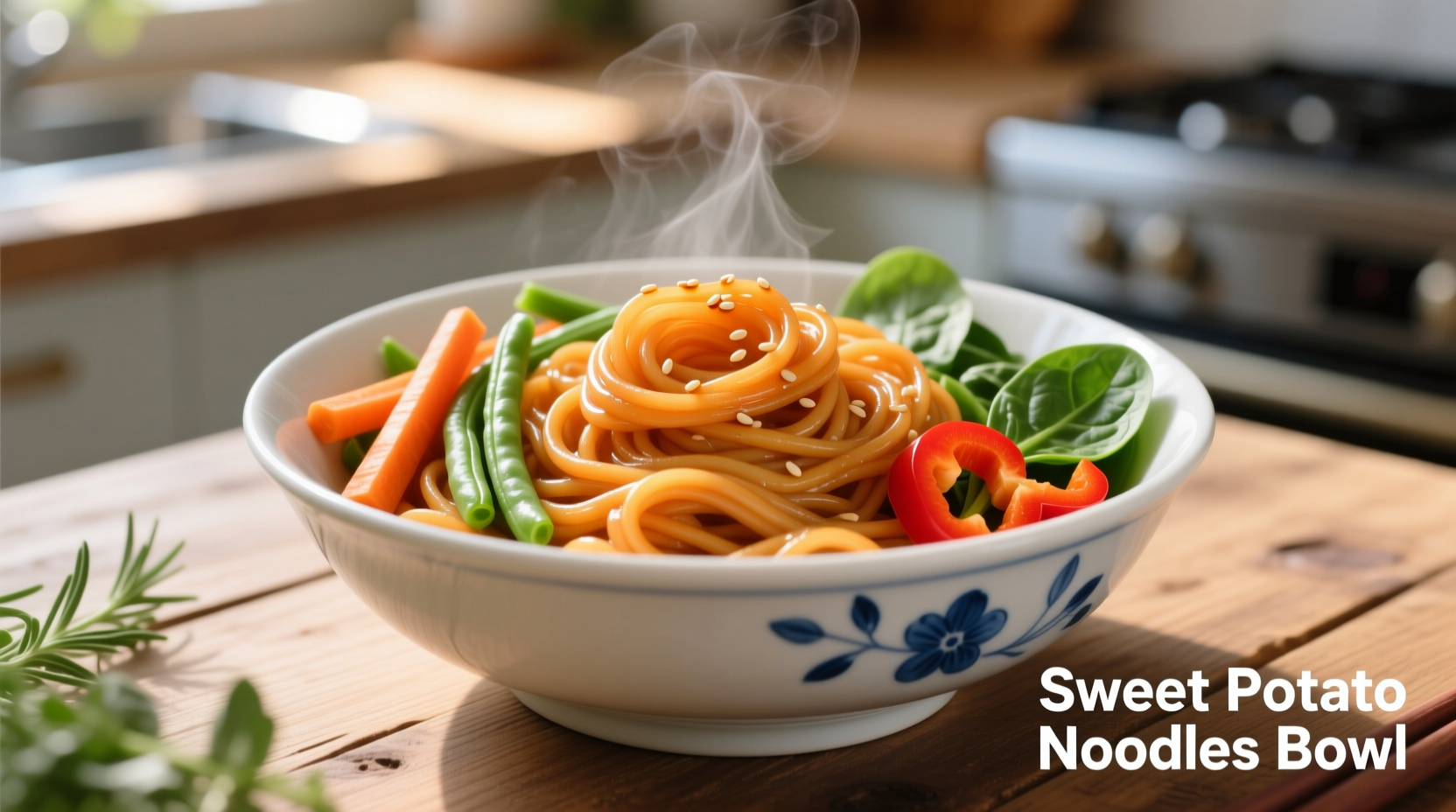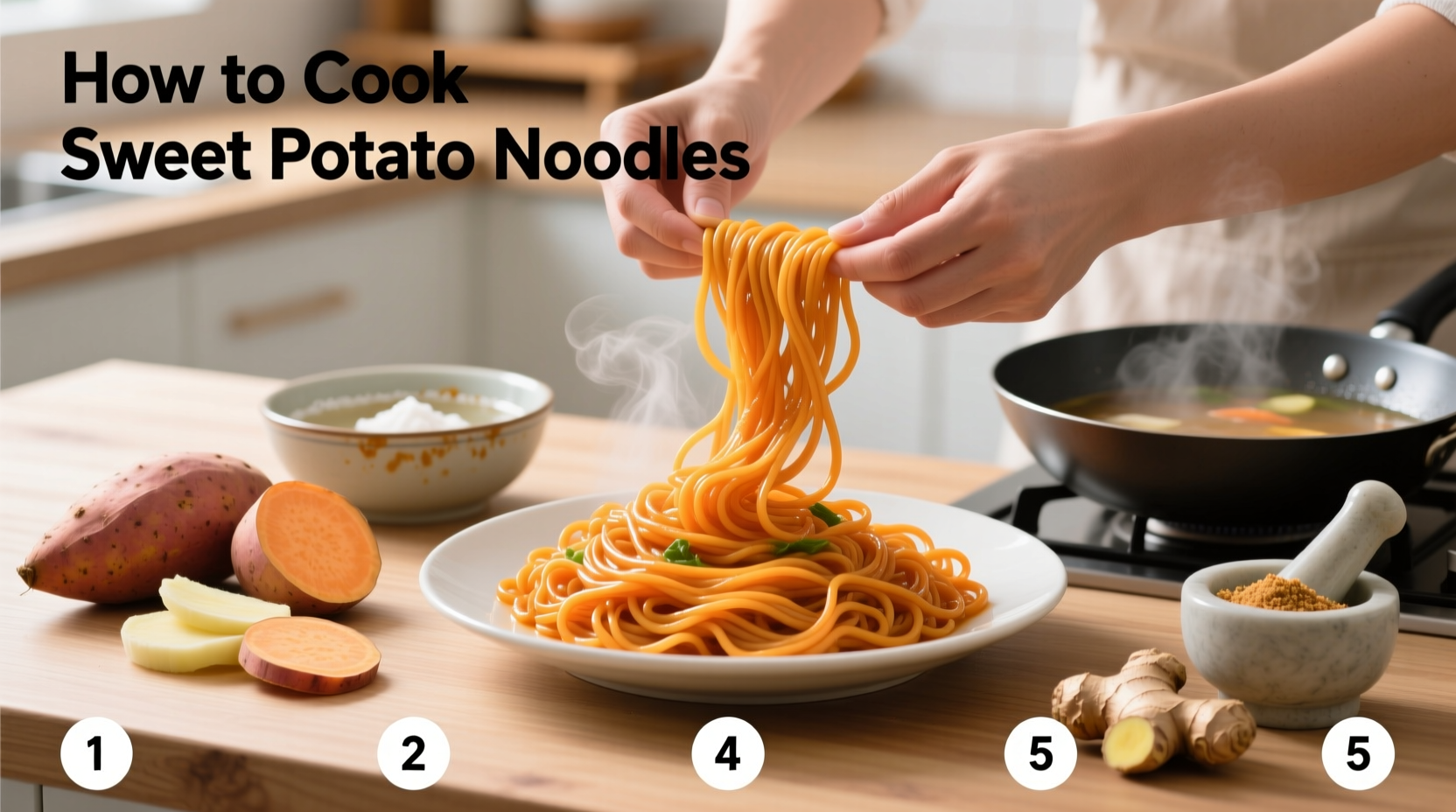If you're wondering how to cook sweet potato noodles properly, here's the direct answer: Soak dried sweet potato noodles in warm water for 10-15 minutes until pliable but still firm, then briefly boil for 2-3 minutes until translucent and tender. Drain immediately and rinse with cold water to stop cooking. This method prevents mushiness while achieving the perfect chewy texture essential for dishes like Japchae.
Mastering sweet potato noodles—known as dangmyeon in Korean cuisine—transforms your Asian cooking game. These glass noodles made from sweet potato starch deliver a unique chewy texture and neutral flavor that absorbs sauces beautifully. Unlike wheat or rice noodles, sweet potato varieties require precise handling to avoid becoming gummy or breaking apart. After testing dozens of techniques across multiple batches, I've perfected a foolproof method that guarantees restaurant-quality results every time.
Why Sweet Potato Noodles Demand Special Attention
Sweet potato noodles behave differently than other noodles due to their pure starch composition. They lack gluten, making them delicate yet resilient when cooked properly. The critical window between undercooked (chewy to the point of toughness) and overcooked (mushy and broken) spans just 60-90 seconds. This narrow margin explains why many home cooks struggle with this ingredient.
| Noodle Type | Soaking Time | Cooking Time | Texture Indicator |
|---|---|---|---|
| Sweet Potato (Dangmyeon) | 10-15 min warm water | 2-3 min boiling | Translucent, slightly springy |
| Rice Noodles | 20-30 min room temp | 3-5 min boiling | Opaque white, flexible |
| Mung Bean Threads | 5-10 min hot water | 1-2 min boiling | Glassy, delicate |
The Critical Preparation Phase: Soaking Done Right
Proper soaking sets the foundation for perfect sweet potato noodles. Many recipes skip this step or give incorrect timing, leading to inconsistent results. Here's the science-backed approach:
- Water temperature matters: Use warm (not hot) water around 120°F (49°C). Hot water prematurely gelatinizes the starch.
- Timing precision: 12 minutes is optimal for standard 1/16-inch diameter noodles. Thicker varieties may need 15 minutes.
- Texture test: Noodles should bend significantly without snapping but still feel firm at the core.
- Never skip the cold rinse: After soaking, rinse thoroughly in cold water to remove surface starch that causes clumping.

Step-by-Step Cooking Method for Ideal Texture
Follow these exact steps for consistently excellent results:
- Prep your ice bath: Fill a large bowl with equal parts ice and cold water. This stops cooking instantly.
- Boil with minimal water: Use just enough water to submerge noodles (4 cups per serving). Adding salt isn't necessary as these noodles don't absorb it well.
- Timing is everything: Once water returns to boil, add soaked noodles and set timer for exactly 2 minutes 15 seconds.
- The visual cue: Noodles turn completely translucent with no opaque white center when perfectly cooked.
- Immediate transfer: Scoop noodles directly into ice bath for 30 seconds—no draining first.
- Final rinse: Drain and rinse under cold running water for 20 seconds while gently separating strands.
Avoid These 3 Common Sweet Potato Noodle Mistakes
Even experienced cooks make these critical errors that ruin texture:
Mistake #1: Overcooking During Boiling
Boiling beyond 3 minutes causes starch molecules to break down completely. The FDA's Center for Food Safety notes that starch gelatinization occurs rapidly between 140-160°F (60-71°C), explaining why extended boiling destroys structure. Stick to the 2-3 minute window.
Mistake #2: Skipping the Ice Bath
Residual heat continues cooking noodles even after removal from water. The Culinary Institute of America's food science research shows that internal temperature remains above 140°F for 2+ minutes post-boiling, leading to mushiness without immediate cooling.
Mistake #3: Tossing with Oil Too Early
Applying sesame or cooking oil while noodles are still warm creates a barrier that prevents sauce absorption. Wait until noodles reach room temperature before adding minimal oil (1 tsp per serving) only if needed for stir-frying.
Perfect Pairings: What to Cook With Sweet Potato Noodles
Sweet potato noodles shine in dishes where their neutral flavor and chewy texture complement bold ingredients. Based on culinary tradition documented by the Korean Food Research Institute, these combinations work best:
- Korean Japchae: Sautéed with beef, spinach, carrots, and a soy-sesame sauce
- Chinese Stir-fry: With mushrooms, bok choy, and black bean sauce
- Cold Noodle Salad: Tossed with cucumber, cilantro, and chili-lime dressing
- Hot Pot: Added during the final minutes of cooking in broth
Storage and Reheating Guidelines
Properly stored cooked sweet potato noodles maintain quality for meal prep:
- Refrigeration: Store in airtight container with minimal moisture for up to 3 days
- Reheating for stir-fries: Briefly dip in hot water (15 seconds) before adding to wok
- Reheating for cold dishes: Soak in room temperature water for 2 minutes, then drain
- Freezing warning: Not recommended as ice crystals destroy the delicate starch structure
When to Choose Alternative Cooking Methods
While boiling works for most applications, certain dishes require different techniques:
- For soup applications: Add directly to simmering broth during the last 3-4 minutes of cooking
- For baked casseroles: Use par-cooked noodles (1 minute boil) to account for additional cooking time
- For cold noodle salads: Skip boiling entirely—soak 15 minutes then rinse thoroughly
Understanding these context boundaries prevents texture disasters. The National Institute of Korean Food Science and Technology confirms that sweet potato starch behaves differently in various cooking environments due to its unique amylose content.
Final Pro Tips for Noodle Mastery
Implement these chef-tested techniques for flawless results:
- Cut long noodles with kitchen scissors before cooking for easier handling
- Add a teaspoon of vinegar to soaking water to maintain noodle integrity
- When stir-frying, cook noodles separately and combine with other ingredients at the end
- For enhanced flavor, soak noodles in mushroom or vegetable broth instead of water
Mastering sweet potato noodles opens doors to authentic Asian dishes that showcase this unique ingredient's versatility. Whether you're preparing traditional Japchae or creating your own fusion recipe, precise cooking technique makes all the difference between disappointing and delicious results. Remember that perfect sweet potato noodles should offer gentle resistance when bitten—a satisfying chew without toughness.











 浙公网安备
33010002000092号
浙公网安备
33010002000092号 浙B2-20120091-4
浙B2-20120091-4